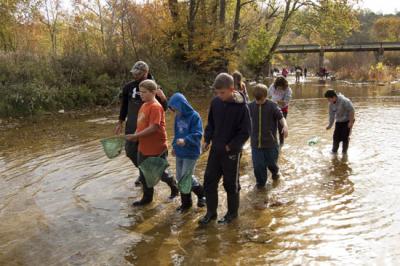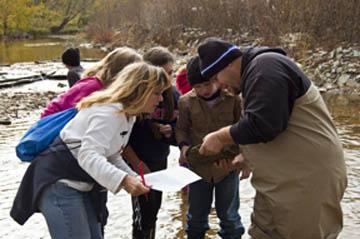The future is in the water
The future is in the water

Scott Darst can see the future. It’s not difficult, because at the moment the future is standing all around him, ankle deep in stream water and squealing with delight when another crawly thing is discovered.
Darst, University of Kentucky Cooperative Extension agent for 4-H youth development in Madison County, recently shepherded Waco Elementary School fifth-graders on a foray into Cane’s Creek. The students are in Amanda Prewitt’s science class, and their watery adventure is part of a yearlong curriculum that mixes lessons on animal and plant life with those on water quality and other forms of environmental pollution. They had been studying macroinvertebrates, and this was their first opportunity to take what they’d learned in the classroom out into the real world.
A boy thrust his bucket toward Darst.
“Is that a leaf or a leech?”
From the looks of it, it could have easily been either, but after nudging it, Darst proclaimed it a leaf. Disappointment washed over the boy’s face. Leaves aren’t nearly as exciting as leeches.
Darst explained that the presence of leeches is a sign of poor water quality. By the end of their morning in the creek, the students would gather their data—a list of aquatic life forms such as crawfish, leeches and fish, among others, pH levels and information on the oxygen content—and determine the health of the stream.
“It is a water-quality issue,” Darst said. “As environmental educators, our goal is not to necessarily give the kids our opinion, but to let them figure it out, let them experience it and experiment.”
Cane’s Creek is a tributary of the Kentucky River, so water that flows through many of these students’ yards will eventually end up in the Gulf of Mexico, via the Ohio and the Mississippi rivers. While many people might not realize the importance of these first order streams, Steven Price, assistant professor in the UK College of Agriculture’s Department of Forestry, said small streams account for more total water than larger rivers, because they are so plentiful throughout the landscape.
Small waterways are most heavily and quickly altered by land-use changes brought on by urbanization or agriculture. Once the streams are impacted, people have to deal with problems from flooding or discover they can’t swim in their river because the water is no longer as clean as it once was.
“It’s because we modified the hydrology of the landscape, because we don’t have all these small drainages anymore. We’ve taken away all these little feeder streams that help keep the river clean or provide nutrients that will supply the wildlife in the system,” Price said. “We really need to think about how we manage water at a scale we’re not always used to thinking about.”
 That’s why educators like Prewitt and Darst joined with Fayette County 4-H agent Eric Comley, the Kentucky Department of Fish and Wildlife Resources and Bluegrass PRIDE to introduce students to the importance of healthy watersheds. Prewitt received support at the very beginning of her stream project with a three-year grant from UK’s Tracy Farmer Institute for Sustainability and the Environment.
That’s why educators like Prewitt and Darst joined with Fayette County 4-H agent Eric Comley, the Kentucky Department of Fish and Wildlife Resources and Bluegrass PRIDE to introduce students to the importance of healthy watersheds. Prewitt received support at the very beginning of her stream project with a three-year grant from UK’s Tracy Farmer Institute for Sustainability and the Environment.
“This all got started when UK allowed me to go to professional development, and they came into my classroom to help me teach these lessons and do these activities,” she said.
This is the fourth year Prewitt’s fifth-graders have tested Cane’s Creek.
“We’re really excited that we’ll be going back and not only graphing and looking at today’s data, but comparing it to the past three years and forecasting how the stream is changing, what we are seeing and where do we rank it. The first year we came out, we were at a high excellent, and the last two years we’ve been at the upper part of good. So it will be interesting to see where the stream falls within their testing today.”
That may have been that day’s lesson, but Prewitt, Darst and the other educators count on this lesson lasting a lifetime.
“If you don’t learn it when you’re young, are you going to care when you’re older?” said John Coffey from the Kentucky Department of Fish and Wildlife Resources.
“I think it’s really important for them to know that they can make a difference where they live,” Prewitt said. “If we all are trying to be more conscious of that, then how does that benefit our whole community? We started at Waco and with our families; now how will that affect Richmond and beyond?”
4 H Youth Extension Forestry & Natural Resources


